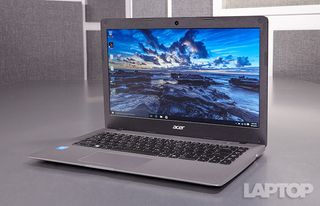Laptop Mag Verdict
Acer's 14-inch Cloudbook offers decent Windows 10 performance, a good keyboard and chart-topping battery life, all starting at just $199.
Pros
- +
Class-leading battery life
- +
Affordable
- +
Clean Windows 10 install
- +
Comfy keyboard
Cons
- -
Lackluster display
- -
Weak speakers
- -
Limited storage
Why you can trust Laptop Mag
Chromebooks are low-priced machines made to run Google's cloud-based Chrome OS, but what's a Cloudbook? A Cloudbook is Acer's idea of an inexpensive everyday computer that's also designed to live in the cloud, but runs Windows 10 instead of Chrome OS. In other words, the netbook trend has come around again. The 14-inch Acer Aspire One Cloudbook starts at just $199 ($249 as reviewed) and comes with an Intel Celeron CPU, 2GB of RAM, 64GB of storage and a free 1TB of cloud storage on OneDrive for a year. But when you dive beneath those pedestrian specs, the Cloudbook hides the endurance of a marathon runner. With this combination of price and battery, is the Cloudbook a Chromebook killer?
Design
Constructed out of nondescript dark-gray plastic, the Acer Cloudbook is the Eeyore of notebooks: dreary but reliable. The top and bottom feature a dimpled texture, and while it's not very exciting to touch, the construction felt relatively sturdy.

Inside, the Cloudbook switches to a matte-black bezel surrounding the screen, with a return to dark gray (this time with a matte finish) on its deck. There's not a lot of flair to the Cloudbook, but really, since the price starts at $199, I don't mind.

The 14-inch Cloudbook measures 13.4 x 9.2 x 0.34-0.7 inches and weighs 3.53 pounds, which is a little heavier than the 14-inch Lenovo IdeaPad 100 (13.4 x 9.3 x 0.8 inches and 3.2 pounds), but otherwise quite similar in size. Toshiba's 13-inch Chromebook 2 is expectedly smaller and lighter, at 8.4 x 12.6 x 0.76 inches and 2.97 pounds, although the 2014 HP Stream 13 is quite comparable, at 13.1 x 9 x 0.77 and 3.4 pounds.
Keyboard and Touchpad
Oftentimes, the typing experience can suffer on budget machine. But with the Cloudbook's standard 1.57mm of key travel and 60-gram actuation weight, I felt right at home the instant I put my fingers to the keys. On my first run-through on the 10fastfingers typing test, I hit 78 words per minute, which is right on a par with my typical average. I also really like the Cloudbook's full-sized arrow keys, which have become a rarity on most modern laptops.

The 4.25 x 2.25-inch touchpad offered a similarly satisfactory experience, with quick responses to both multifinger gestures and general mouse movement. The only quirk I noticed was that every time I opened the lid, the system displayed a momentary warning saying that touchpad was disabled. However, this didn't seem to cause a delay in actually getting a reaction.
Display
If the Cloudbook had a more colorful display, it would have a leg up on even the best Chromebooks. When I viewed movies and photos, colors looked muted and a little lifeless on the notebook's 14-inch, 1366 x 768 display. This was most evident when I watched the Transformers: Devastation trailer; despite the neon sparks of the robot's attacks, action didn't pop like it did on other displays.

The Cloudbook registered 244 nits of brightness, which was dimmer than both the Toshiba Chromebook 2 (378 nits) and the Lenovo IdeaPad 100 (260 nits), but brighter than the truly dim HP Stream 13 from 2014 (166 nits).
Color accuracy wasn't great, as the Cloudbook earned a Delta-E rating of 3.78 (numbers closer to zero are better). This put it well behind the Chromebook 2, which scored 0.9.
The Cloudbook's biggest failing was its color range, which covered just 53.4 percent of the sRGB spectrum. That's significantly lower than the scores of the Chromebook 2 (110 percent) and the HP Stream 13 (79 percent).
Audio
Sound quality on the Acer Cloudbook is its weakest trait. The notebook's audio range is focused almost entirely in the upper mids. Highs were generally tinny, and the lows had almost no impact. When I listened to Stan Bush's "You've Got the Touch," the cymbals sounded like they were made out of aluminum foil, while the snares and bass sounded shallow and far away.
Heat
On the Laptop Mag Heat Test (15 minutes of streaming HD video from Hulu), the top of the Acer Cloudbook stayed cool, measuring 80.5 degrees Fahrenheit on the touchpad and 83 degrees between the G and H keys. Unfortunately, things were less comfortable on the bottom of the laptop, where the Cloudbook surpassed our 95-degree comfort threshold, with a reading of 97 degrees. That's hardly a deal breaker, though.
Ports and Webcam
With an HDMI port, SD card reader, combo headphone/mic jack and just two USB ports (one USB 3.0, one USB 2.0), Acer's Cloudbook is one port short of what you typically get on a 14-inch system.
As for the webcam, the low-res 640 x 360 shooter above the display captured images that were both soft and grainy.

This can be seen in a selfie I took in our well-lit office, which came out dark, noisy and without a lot of detail -- especially in my hair and shirt.
Performance and Graphics
With a 1.6-GHz Intel Celeron N3050 CPU, 2GB of RAM and just 64GB of storage, the Cloudbook was never going to be a processing powerhouse. However, if you need it just to browse the Web, check emails, or fiddle around in a spreadsheet or two, Acer's Cloudbook is totally capable. When I had 10 more or tabs open in Chrome or Edge (Microsoft's replacement for Internet Explorer), some lag started to appear, such as waiting slightly for text to appear when typing in a search bar.
Using Geekbench 3, which tests overall system performance, a 1,646 score from the Cloudbook trailed both the Lenovo Ideapad 100 (2,446 with an Intel N2840 CPU) and the 2014 HP Stream 13 (1,802 also with an Intel N2840 CPU).
When put up against Toshiba's recently revamped Chromebook 2 using the Sunspider JavaScript benchmark, the Cloudbook took longer to complete the test, at 432.4 ms, versus 324.9 ms for the Toshiba. However, it did beat the HP Stream 13 from 2014, which had a time of 522.3 ms.
On the bright side, the 64GB of eMMC storage recorded transfer speeds of 48 MBps, which were faster than those of the IdeaPad 100's 500GB HDD (34.4 MBps) and the 2014 HP Stream 13 (27.2 MBps).
When we used OpenOffice to match 20,000 names and addresses, the Cloudbook finished in 15 minutes and 8 seconds. That's almost exactly the same as the HP Stream 13 from 2014 (15:12) and a few minutes faster than the IdeaPad 100 (18:06).
We then timed how long it took the Cloudbook to open a 69MB Word document in OpenOffice, and the Cloubook's time of 36.5 seconds isn't bad. In a recent roundup of sub-$500 notebooks, the average time was 40.2 seconds. However, when we repeated the test, this time with our file-copy test also running in the background, the Cloudbook took a much longer 1 minute and 39 seconds.
When we tested graphics performance, the Cloudbook scored 18,605 in 3DMark's Ice Storm Unlimited benchmark, which was better than the IdeaPad 100 (15,481) and the HP Stream 13 (10,084). When I played Hearthstone: Heroes of Warcraft, I was able to get through a game at 1366 x 768 and medium settings with only a few instances of lag or stuttering.
Battery Life
This is the standout feature of Acer's Cloudbook, a battery that lasts almost 15 hours on a charge. To be exact, on Laptop Mag's Battery Test (Web surfing over Wi-Fi at 100 nits), it took 14 hours and 43 minutes for the 14-inch Cloudbook to finally run out of juice. That's more than 4 hours longer than Toshiba's revamped Chromebook 2, which already has an impressive life of 10:05, double the battery life of the 2014 HP Stream 13 (6:26) and almost triple that of Lenovo's IdeaPad 100 (4:45).
MORE: Laptops with the Longest Battery Life
Configurations
Our $250 14-inch Acer Aspire One Cloudbook is the most expensive model in the range, featuring an Intel Celeron N3050 CPU, 2GB of RAM and 64GB of flash storage. If you can do with less onboard drive space, there's a cheaper, $199 model featuring just 32GB of eMMC memory. For those who prefer a smaller and more portable machine, Acer also offers an 11-inch Cloudbook starting at $170, although it comes with just 16GB of local storage.
Software and Warranty
The Cloudbook features a standard one-year warranty and comes preloaded with a superclean install of Windows 10. To help make your transition to the cloud easier, Acer also includes a free one-year subscription to Microsoft Office and 1TB of storage on Microsoft OneDrive. And because you're running Windows, you aren't limited to apps from Google's Web store like you are on a Chromebook.
Bottom Line
Acer's Cloudbook really makes you wonder: Why get a Chromebook? The best thing Chromebooks had going for them was their low price, but with the Cloudbook you get nearly 15 hours of battery life for $249, or less. Besides, if you need Chrome in your life, there's nothing stopping you from installing Google's Web browser and getting the same basic experience, but with the added flexibility of full Windows compatibility.
A little more RAM would help smooth out some of the stuttering, and I wish the screen were a little more colorful. But the comfy keyboard and solid, if uninspired build quality make for a great budget machine, whether you're working offline or in the cloud.
Acer Aspire One Cloudbook (14-inch) Specs
| Bluetooth | Bluetooth 4.0 |
| Brand | Acer |
| CPU | 1.6-GHz dual-core Intel Celeron N3050 |
| Card Slots | SD memory reader |
| Company Website | www.acer.com |
| Display Size | 14 |
| Graphics Card | Intel HD Graphics |
| Hard Drive Size | 64GB |
| Hard Drive Type | eMMC |
| Native Resolution | 1366x768 |
| Operating System | Windows 10 |
| Optical Drive | None |
| Ports (excluding USB) | USB 3.0, HDMI, Headphone/Mic, USB 2.0 |
| RAM | 2GB |
| Size | 13.4 x 9.2 x 0.34-0.7-inches |
| Touchpad Size | 4.25 x 2.25-inches |
| Video Memory | Shared |
| Warranty/Support | one-year |
| Weight | 3.53 pounds |
| Wi-Fi | 802.11ac |
